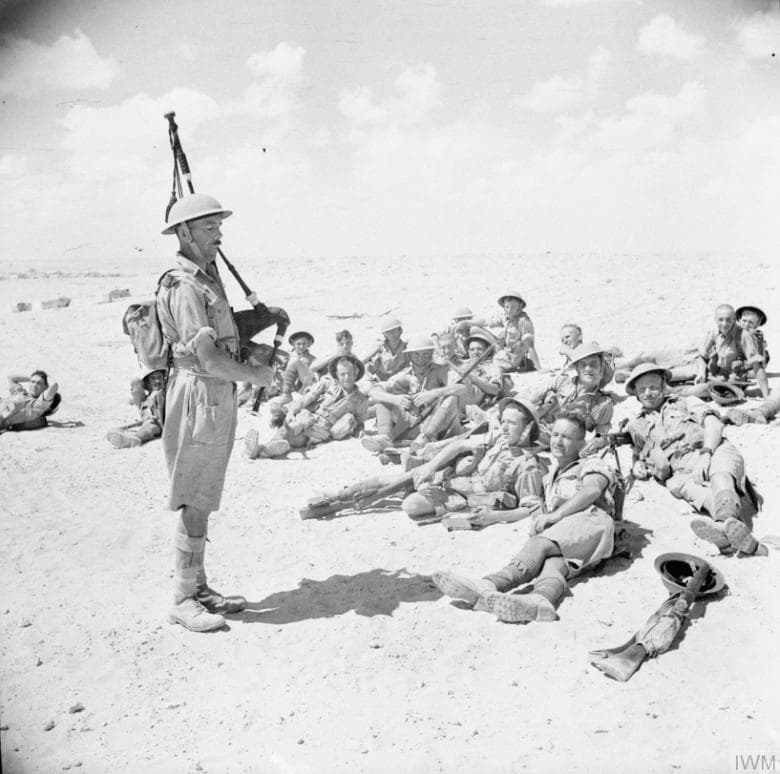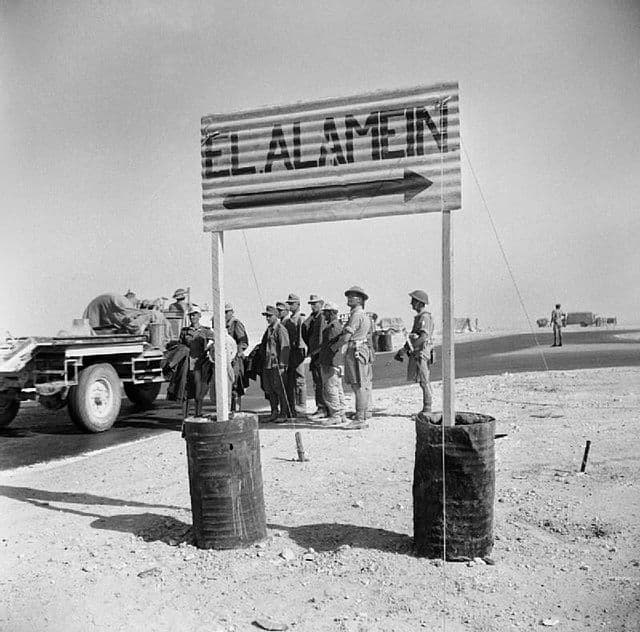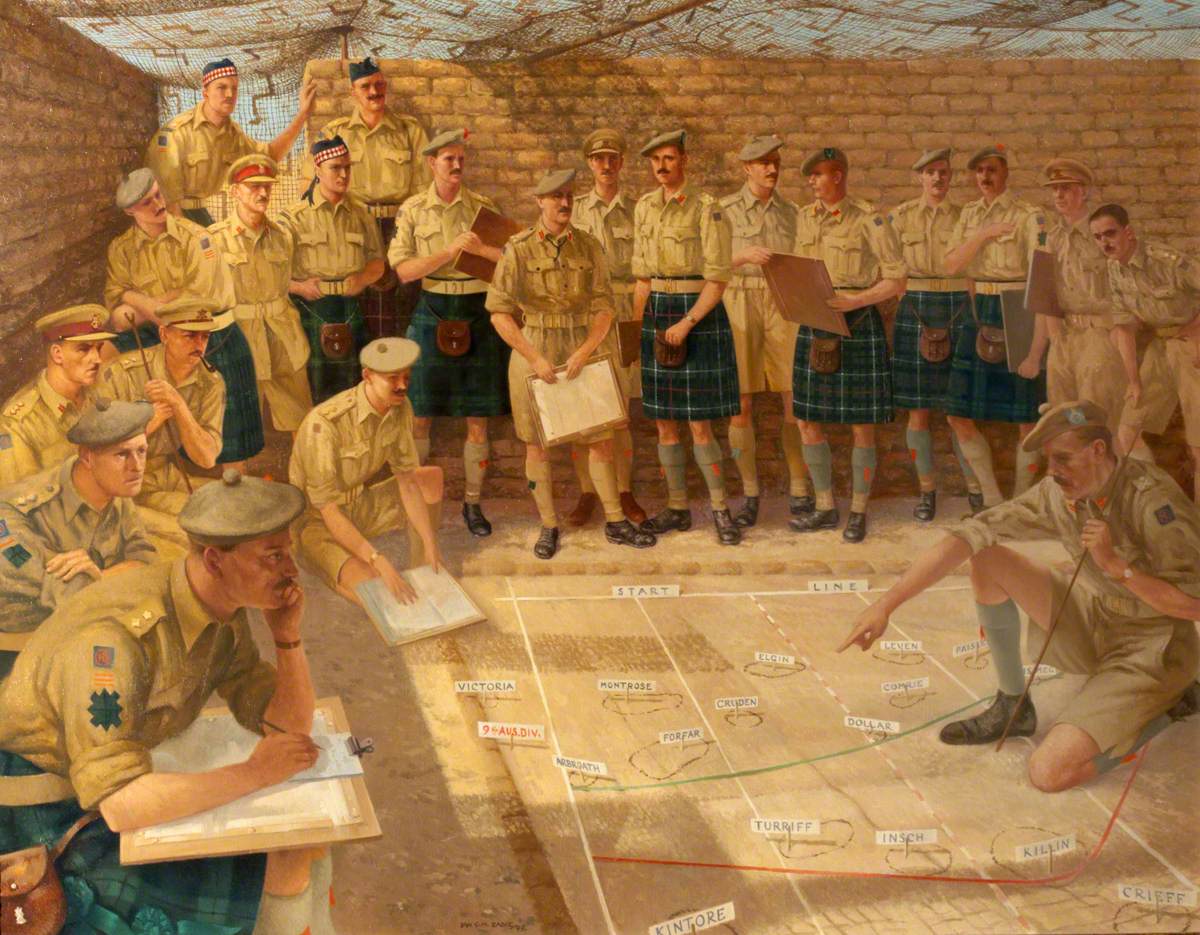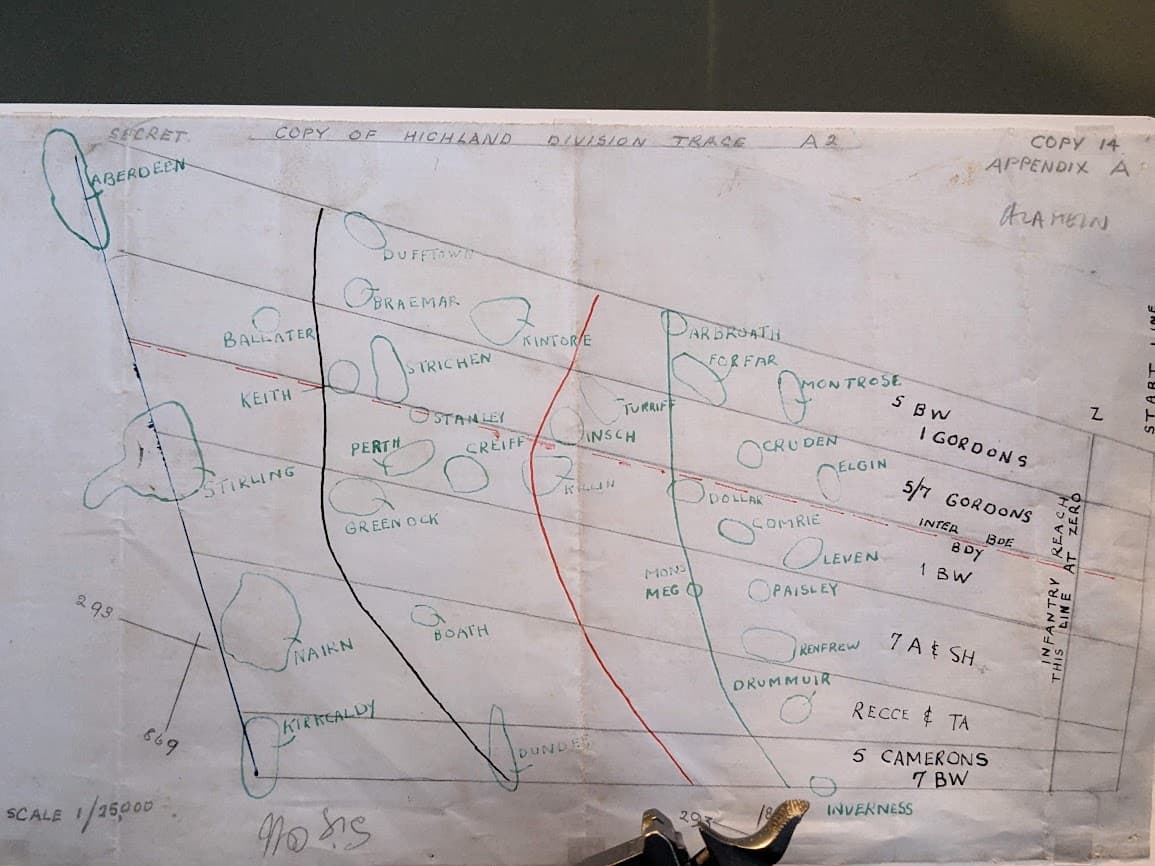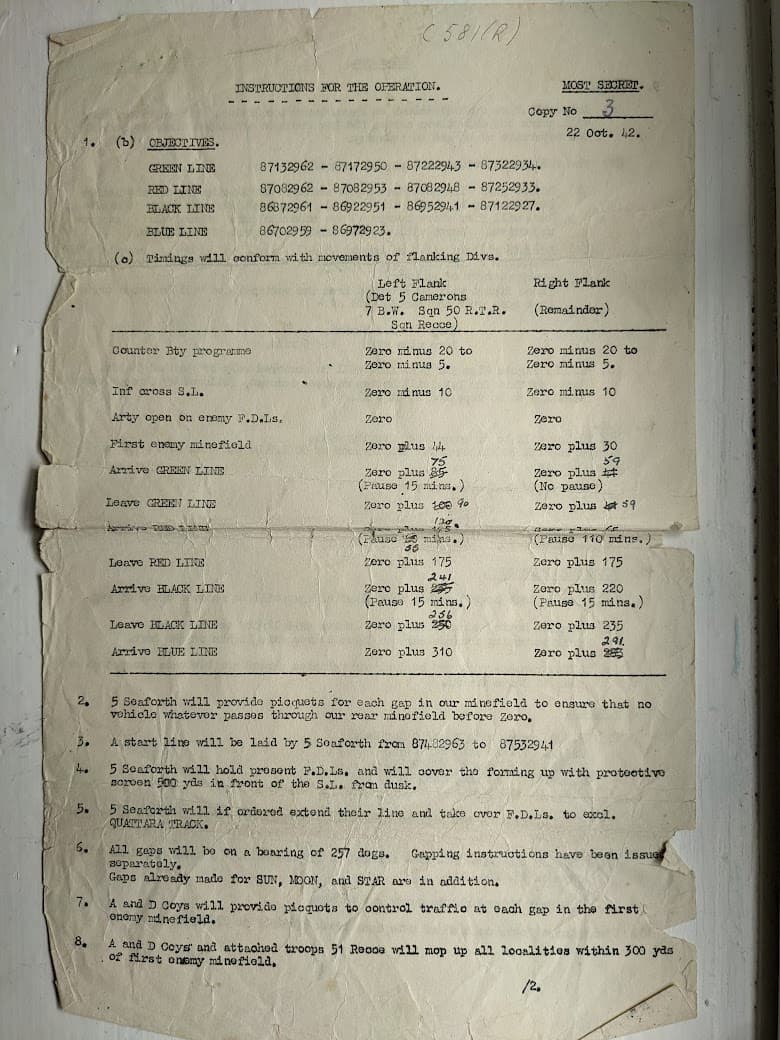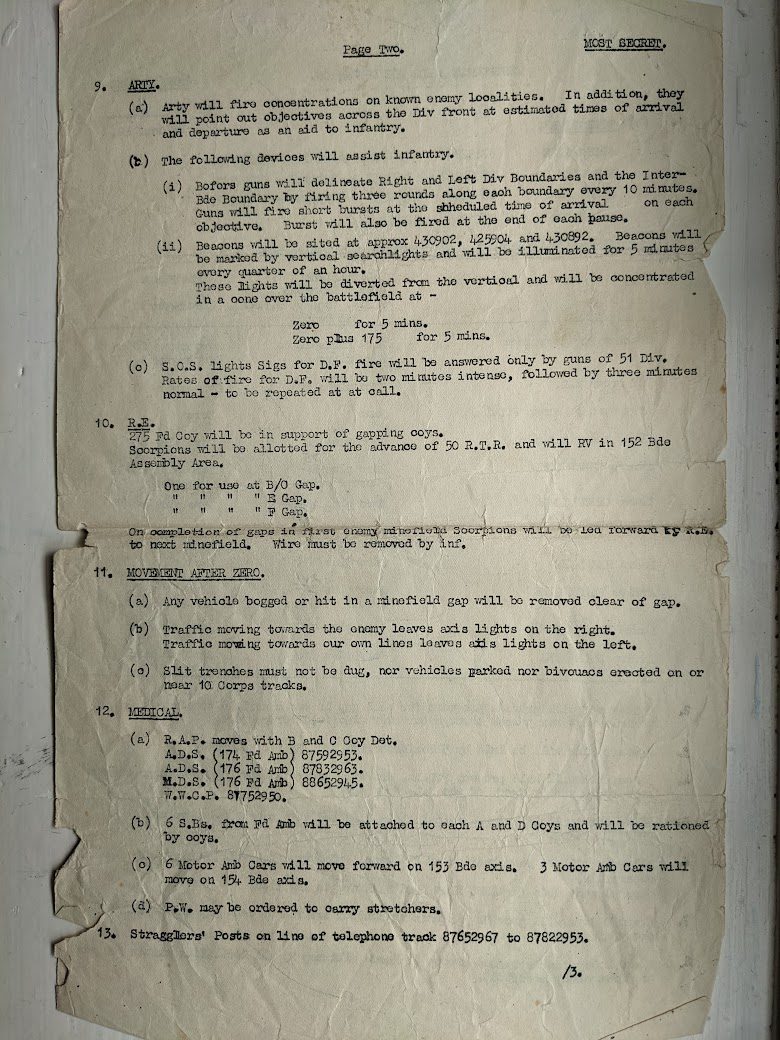El Alamein Anniversary Special Part 1:
Operation Lightfoot
The second Battle of El Alamein that began on 23rd October 1942 is remembered as one of the key turning points in WWII. General Bernard Montgomery’s plan to push Rommel’s army back from the Egyptian border and out of North Africa achieved stunning success and helped the newly reformed 51st Highland Division restore the reputation of the Highland Regiments after their capture at St Valery in 1940.
The Allied plan was divided into three parts: the break-in, through the enemy minefields; the crumbling of their supplies and armour; and the break-out, an armoured push through the enemy defensive lines. The first part, the break-in, was codenamed Operation Lightfoot.
The four infantry divisions of XXX Corps, including the 51st Highland Division, were to advance on a 16 mile (26 km) front, over-running the forward Axis defences. Engineers would clear and mark the two lanes through the minefields, through which the armoured divisions from X Corps would pass. They would rally and consolidate their position just west of the infantry positions, blocking an Axis tank counter-attack. The British tanks would then advance deep in the Axis defensive system, to challenge the Axis armour. The infantry battle would continue as the Eighth Army infantry “crumbled” the deep Axis defensive fortifications and destroy any tanks that attacked them.
5th Battalion Queens Own Cameron Highlanders were part of the 152nd Brigade of the 51st Highland Division and were split to carry out two separate tasks. A & D Companies provided eight covering parties to protect the sappers making gaps in the enemy minefields. B & C companies were detached to 154th Brigade and were to lead the assault on the extreme left flank of the Division.
So how do you keep command and control over 800 men and motor transport in the middle of the night across a barren, featureless desert with all hell breaking loose and no modern-day satellite navigation or communication systems? An original copy of the 32 point “Instructions for the Operation” (IO) that was issued for Operation Lightfoot and held in the museum archive gives some idea.
First, state clear objectives and timings.
The IO notes the Grid Reference of the four lines to be reached, Green, Red, Blue and Black, progressively further into the enemy minefields and the times of arrival and moving on. Timings are all reference to Zero hour, D day, although the actual date (23rd October 1942) and zero hour are not included but state that zero hour will be notified separately (actually 22:00). The attack started at zero minus 20 minutes with a counter battery barrage, infantry crossing the start line at zero minus 10 with artillery opening up on the enemy FDLs (Forward Defence Lines) at zero hour.
Arrival at green line was +75 minutes for the Left flank which included the 5th Camerons detachment, +59 minutes for the remainder on the Right Flank. The Left flank was to pause for 15 minutes before pushing on to the Red line, arriving zero +120, pausing, pushing on to the Black line, pausing before finally arriving at the Blue line at zero +310 minutes i.e. 4.5 hrs after the start.
Sections 2 -9 in the Instructions provide more detail – where the start line is, how gaps in the minefields are to be guarded (with piquets from 5th Seaforth), enemy minefields and mopping up by A & D Companies.
The artillery was to fire on known enemy locations and at the objective lines, ahead of the infantry. As the attack was to be done in pitch dark, beacon lights were set up at three specific locations to shine vertically every 15 minutes to aid position plotting, and horizontally at zero +5 and +175 minutes, to briefly illuminate the battlefield.
Mine clearance would be done by sappers from the Royal Engineers working in advance of 50 Royal Tank Regiment. The wire to be removed by the infantry following. Other sections included:
Section 11 MOVEMENT AFTER ZERO. Any vehicle bogged down or hit to be removed clear of the minefield gap. Traffic moving towards the enemy has right side lights on, away from the enemy the left lights, so that they pass either side of each other without colliding.
Section 12 MEDICAL Details where the ADS (Advanced Dressing Station) MDS (Main Dressing Station) and WWCP (Walking Wounded Collecting Post) are located and the Field Ambulance attending. Interestingly it states that PW (Prisoners of War) may be ordered to carry stretchers. The coordinates of the stragglers posts, for those that become lost, are given.
Section 14 PW gives the coordinates of the PW cage, detailing the 5th Seaforth’s to take over PWs on the Allied Forward Defence Line. Minimum escorts with slightly wounded as guards if possible.
Section 16 SUCCESS SIGNALS & CODE WORDS unsurprisingly use suitable Highland terms like porridge and haggis to signal successfully reaching each objective line.
Section 18 to 24 detail security and recognition such as the Ground to Air and Ground to Ground recognition, critical for avoidance of Friendly Fire incidents. There is a note that (Bristol) Beaufighter ground attack aircraft will be flying over troops during the attack, so that they would not be mistakenly shot at. All troops were instructed to wear a night distinguishing white St Andrews cross on their back
The password UNCLE was to be used up to 1200 Hrs D+1 then HARPER until 12:00 hrs D+2.
Section 26 details the order of movement of assaulting troops:
Section 27 reproduces Major General D.N.Wimberley’s order which showed that his 51st Highland Division meant business:
“THERE WILL BE NO SURRENDER OR UNWOUNDED MEN. ANY TROOPS OF THE CAMERON HIGHLANDERS WHO ARE CUT OFF WILL CONTINUE TO FIGHT. The vital part which such pockets of resistance will play in obtaining victory must be impressed on all ranks before battle”.
Section 28 details an extensive list of Supply (Sups) information
a). General All Sups for D to D+3 will be dumped in forward area. On no account will dumps for assaulting troops be opened by this unit.
b). Ammunition: 1st line reserves split and dumped one third B&C Coy area, two thirds Bn HQ area. The IO (information Officer) had trace of dumps in case signs were removed or destroyed.
c). POL All vehicles will have full tanks. Reserves normally carried on carriers will NOT be taken forward but will be dumped in Bn HQ petrol dump. MTO (Motor Transport Officer) will not draw until 1st line reserve is exhausted.
d). Sups
i). Hot meal will be served after dark on D day. One day’s battle ration will be issued.
ii). D+1 Battle ration carried on man and full water bottles
iii). 3 days battle rations and 3 days water (at a gallon per man) will be dumped as for amunition for D+2 to D+4.
It goes on to state that “Although water is being dumped at one gallon per man per day there will be losses and Coys must not expect more than fifty per cent of that amount”.
Being the army, reporting of strength and status were essential with orders to render daily and punctually by hand to Battalion HQ: Strength by 06:00, Ration & Petrol required by 12:00 and Ammunition expenditure by 16:00 hrs. Number of casualties and POWs taken to be notified immediately they occur i.e. not to wait for the daily strength report.
Soberingly, Section 30 covers Burials of those killed, which wherever possible to be done in authorised cemeteries. Scattered graves must be avoided. Only if casualties are very heavy will unit cemeteries be used. The padre assigned to the unit was Rev B.Wilkinson located with the 174 Field Ambulance.
The orders were signed and issued by the Adjutant, Captain A.R.G.Pringle-Pattison and timed at 18:00 hrs 22nd October 1942, the day before the assault. An amendment was issued the following day, 23rd October (D Day) with slightly revised timings.
Perhaps the last word should be left to Captain Grant Murray 5th Seaforths, patrolling the start line “Suddenly the whole horizon went pink and for a second or two there was still perfect silence and then the noise of the 8th Army’s guns hit us in a wall of sound that made the whole earth shake. Through the din we made out other sounds – the whine of shells overhead, the clatter of machine guns…And eventually the pipes. Then we saw a sight that will live forever in our memories – line upon line of steel helmeted figures with rifles at the high point, bayonets catching in the moonlight and over all the wailing of the pipes”.
By Craig Durham, Volunteer at The Highlanders’ Museum (Queen’s Own Highlanders Collection)
Read Part 2 below.

